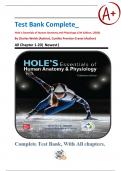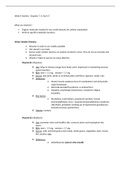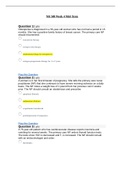Test Bank Complete_
Hole's Essentials of Human Anatomy and Physiology 15th Edition, (2024)
By Charles Welsh (Author), Cynthia Prentice-Craver (Author)
All Chapter 1-20| Newest|
,UNIT 1- LEVELS OF ORGANIZATION _____________________________________________ 3
Chapter 1. Introduction To Human Anatomy And Physiology ____________________________ 3
Chapter 2. Chemical Basis of Life __________________________________________________ 41
Chapter 3. Cells ________________________________________________________________ 69
Chapter 4. Cellular Metabolism ___________________________________________________ 97
Chapter 5. Tissues_____________________________________________________________ 116
UNIT 2- SUPPORT AND MOVEMENT __________________________________________ 143
Chapter 6. Integumentary System ________________________________________________ 143
Chapter 7. Skeletal System _____________________________________________________ 157
Chapter 8. Muscular System ____________________________________________________ 183
UNIT 3- INTEGRATION AND COORDINATION ___________________________________ 211
Chapter 9. Nervous System _____________________________________________________ 211
Chapter 10. The Senses ________________________________________________________ 242
Chapter 11. Endocrine System ___________________________________________________ 265
UNIT 4- TRANSPORT _______________________________________________________ 293
Chapter 12. Blood _____________________________________________________________ 293
Chapter 13. Cardiovascular System _______________________________________________ 321
Chapter 14. Lymphatic System and Immunity ______________________________________ 350
UNIT 5- ABSORPTION AND EXCRETION ________________________________________ 367
Chapter 15. Digestive System and Nutrition ________________________________________ 367
Chapter 16. Respiratory System _________________________________________________ 388
Chapter 17. Urinary System _____________________________________________________ 407
Chapter 18. Water, Electrolyte, and Acid-Base Balance _______________________________ 424
UNIT 6- THE HUMAN LIFE CYCLE _____________________________________________ 440
Chapter 19. Reproductive Systems _______________________________________________ 440
Chapter 20. Pregnancy, Growth, Development, and Genetics __________________________ 455
,UNIT 1- LEVELS OF ORGANIZATION
Chapter 1. Introduction To Human Anatomy And Physiology
Charles Welsh: Hole's Essentials of Human Anatomy & Physiology 15th Edition, (2024) Test Bank
MULTIPLE CHOICE
1) The Anatomical Term For The Forearm Is:
A) Brachial
B) Antebrachial
C) Carpal
D) Radial
ANS: B)
The Forearm Is The Region Of The Upper Limb Between The Elbow And The Wrist.
In Anatomical Terminology, The Term "Antebrachial" Specifically Refers To This
Area. Brachial Refers To The Upper Arm, Which Is The Section Of The Arm
Between The Shoulder And The Elbow.
Carpal Pertains To The Wrist, Which Is The Joint Connecting The Forearm To The
Hand. Radial And Ulnar Refer To The Two Bones In The Forearm (The Radius And
Ulna), But Do Not Specifically Describe The Entire Forearm Region.
2) What Investigator Would Conduct An Experiment To Determine How
Temperature Changes Affect The Rate At Which The Heart Beats?
A) Anatomist
B) Physiologist
C) Chemist
D) Biochemist
ANS: B)
A Physiologist Studies The Functions And Mechanisms Of Living Organisms. In This
Case, Understanding How Temperature Affects Heart Rate Involves Exploring
Physiological Responses, Making A Physiologist The Most Appropriate Investigator.
,Anatomists Focus On Structures, Chemists Deal With Substances And Their
Reactions, Biochemists Study Chemical Processes In Living Organisms, And
Pharmacologists Focus On Drug Effects On Biological Systems.
3) Blood Plasma Is An Example Of What Type Of Fluid?
A) Intracellular
B) Extracellular
C) Serous
D) Acidic
ANS: B)
Blood Plasma Is The Liquid Component Of Blood And Is Classified As Extracellular
Fluid. This Fluid Exists Outside Cells And Includes All Bodily Fluids That Are Not
Contained Within Cells. Intracellular Fluid Is Found Inside Cells, Serous Fluid Is A
Specific Type Of Extracellular Fluid In Body Cavities, And Acidic Does Not
Describe A Fluid Type. Interstitial Fluid Is A Subset Of Extracellular Fluid Found In
The Spaces Between Cells, But Plasma Specifically Refers To The Liquid In Blood.
4) Which Of The Following Lists Illustrates The Idea Of Increasing Levels Of
Organization?
A) Molecules, Cells, Tissues, Organs, Organ Systems
B) Tissues, Cells, Organs, Molecules, Organ Systems
C) Organs, Molecules, Organ Systems, Cells, Tissues
D) Cell, Atom, Tissue, Molecule, Macromolecule
ANS: A)
This List Accurately Reflects The Hierarchical Organization Of Biological Structures.
Starting From Molecules, Which Are The Smallest Units, To Cells, Then Tissues,
Organs, And Finally Organ Systems, It Illustrates A Clear Progression From Simple
To Complex. The Other Options Either Misorder The Levels Or Include Incorrect
Components For Biological Organization.
5) In A Crisis, The Heart Beats Faster And More Forcefully. What Effect Would This
Have On Hydrostatic Pressure?
,A) An Increase In Hydrostatic Pressure
B) A Decrease In Hydrostatic Pressure
C) No Change In Hydrostatic Pressure
D) An Increase In Blood Volume
ANS: A)
When The Heart Beats Faster And More Forcefully, It Increases Cardiac Output,
Which Raises Blood Pressure. Hydrostatic Pressure Is The Pressure Exerted By A
Fluid Due To Gravity, And An Increase In Heart Rate And Force Leads To Higher
Pressure Within The Blood Vessels. The Other Options Are Not Directly Related To
The Primary Effect Of Increased Heart Rate On Hydrostatic Pressure.
6) The Temperature In A Room Drops To 65°F, Causing The Heater To Turn On. The
Temperature Change Is An Example Of A(An):
A) Effector
B) Receptor
C) Stimulus
D) Response
ANS: C)
In This Scenario, The Drop In Temperature Acts As A Stimulus That Triggers The
Heater (The Effector) To Respond By Increasing The Temperature. A Receptor
Would Detect The Change In Temperature, But The Temperature Drop Itself Is
Classified As The Stimulus Prompting The Reaction.
7) Which Of The Following Is Considered One Of The Characteristics Of Life?
A) Digestion
B) Respiration
C) Metabolism
D) Absorption
ANS: C)
Metabolism Encompasses All The Chemical Reactions That Occur Within An
Organism To Maintain Life, Including Both Anabolism (Building Up) And
, Catabolism (Breaking Down). While Digestion, Respiration, Absorption, And Growth
Are Important Processes That Relate To Metabolism, Metabolism Itself Is The
Overarching Characteristic That Defines Life.
8) The Ability Of An Organism To Sense Changes In Its Body Is An Example Of:
A) Movement
B) Respiration
C) Responsiveness
D) Absorption
ANS: C)
Responsiveness Refers To An Organism's Ability To Detect And Respond To
Changes In Its Environment, Including Internal Changes Within The Body. This
Characteristic Is Essential For Maintaining Homeostasis. Movement, Respiration,
And Absorption Are All Vital Life Processes, But They Do Not Specifically Pertain
To Sensing Changes.
9) What Is The Definition Of Metabolism?
A) All The Cells In The Body
B) All Of The Homeostatic Setpoints In The Body
C) All Of The Chemical Reactions In The Body
D) All Of The Organs In The Body And Their Parts
ANS: C)
Metabolism Is Defined As The Sum Of All Chemical Reactions That Take Place In
The Body, Allowing For Energy Production, Growth, And Maintenance Of Cellular
Functions. The Other Options Do Not Accurately Capture This Definition, As They
Describe Structures Or Processes Rather Than The Chemical Reactions Specifically.
10) What Is/Are The Origin(S) Of Many Of The Terms In Anatomy And Physiology?
A) Greek And Latin
B) Spanish And Portuguese
C) French And German
D) Chinese And Japanese






